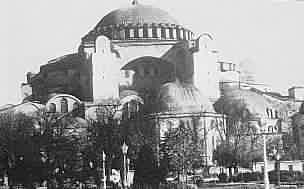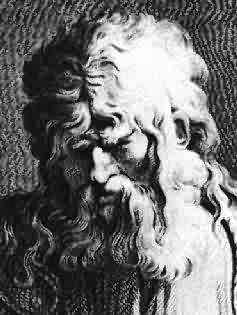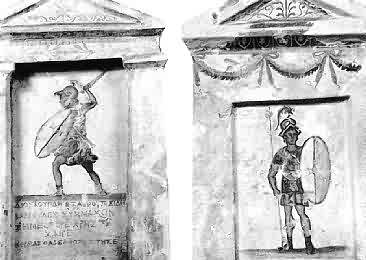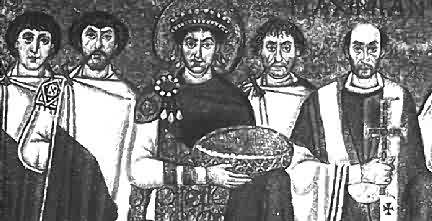

MARCH OF THE TITANS - A HISTORY OF THE WHITE RACE
CHAPTER 20 : BYZANTINE -
THE EASTERN ROMAN EMPIRE
Constantinople, situated on the Bosporus Straits at the mouth of the Black Sea, became a capital of the Roman Empire in 330 AD after Constantine the Great, the first Christian emperor, refounded the city of Byzantium. Although the city was called Constantinople until its fall, the Eastern Roman Empire became known by the classical name of Byzantine, and often the city was called by its old name as well.
The city's status as residence of the Eastern Roman Emperor made it into the premier city in all of the Eastern Roman colonies in the Balkans, Syria, Jordan, Israel, Lebanon, Cyprus, Egypt, and part of present day Libya. A good indication of the degree to which the Eastern Empire was not made up for the greatest part of original Romans, can be seen in the official languages of the Byzantines: Greek, Coptic, Syriac and Armenian, with only a very few mainly Christian priests actually speaking Latin.


Left: Constantine, the bringer of Christianity to the Roman Empire, and therefore also ultimately to Europe. The city he was to found, Constantinople, would last until 1453, when it was overrun by the Nonwhite Muslims. Right: A view of the Haga Sofia - the Christian church built in Constantinople by the Eastern Roman Emperor Justinian in 537 AD. When Constantinople was overrun by the Nonwhite Muslims, four Muslim towers, called minarets, were added to the corners of the building. In this photograph, the minarets have been removed to present the building as it was when it was built.
THE EFFECT OF THE FALL OF ROME
The sacking of Rome by the Visigoths and Vandals, and then the de facto collapse of Roman power in the west, was felt through the Eastern Roman Empire like a thunderclap. The impossible had happened - the power which had held sway in the known world had vanished.
Due to the immense symbolism of Rome, Eastern Roman emperors made two attempts to recapture the west, once ironically using Romanized Germans. This use of Germans, Goths and eventually even Vikings (in the Varangian Guard in Constantinople) was the major reason why the Eastern Empire lasted as long as it did.
Surrounded by huge walls, defenses erected by the Romans at the height of their power, and defended by armies of Germanic mercenaries, Constantinople ended up surviving as a city virtually besieged for the greater part of its life, its territories eventually restricted to the direct area of the city.
THEODORIC THE OSTROGOTH SEIZES THE WESTERN EMPIRE
The first attempt to re-establish the Western Empire by the Eastern Empire came with the invasion of Italy by the Romanized king of another Gothic tribe, Theodoric of the Ostrogoths, soon after the sacking of Rome. Having been educated in Constantinople, Theodoric saw it as his mission to restore the Western Empire.
After much heavy fighting between the Ostrogoths and their racial cousins who had moved into Rome with Odovacar, the two sides reached a stalemate and negotiations were started. However, Odovacar was assassinated and Theodoric seized his chance - taking advantage of the confusion in Odovacar's followers, he established the Ostrogothic kingdom in Italy - significantly not choosing Rome as his capital, instead making the northern Italian city of Ravenna the capital of his revived Western Empire.
Theodoric did his best to restore the outer trappings of classical Rome, even adopting Latin as the language of his court. However, when he died in 526 AD, the temporary order imposed upon Rome and southern Italy once again collapsed, descending into anarchy until the second attempt to restore the Western Empire, made by the famous Eastern Roman emperor, Justinian, in 554 AD.
JUSTINIAN - LAST EMPEROR TO UNITE THE EMPIRE
Justinian, who reigned from 527 to 565 AD, had been able to seize a large slice of North Africa from the remnants of the Vandals in 533, and thus had a good base for an invasion of Italy.
After many years Justinian was able to capture not only Italy, but also Spain and the Aegean coast, for a while almost re-establishing the Roman Empire's borders before it had moved north of the Alps. It is of significance that the army which Justinian sent to conquer these lands, was under the leadership of a general Belisarus - who was a Romanized Slav (and thus an original Indo-European).


Left: Belisarus, the Romanized Slav who served the Eastern Roman Empire. Sent by the Emperor Justinian to reconquer the lands of the western empire from the Germanics, the Nordic Slavic general did in fact manage to capture almost all of the former Western Empire territories - including much of Italy, Spain and the North African coast. Belisarus' most astounding feats were the 40 successive victories he obtained against the (by then mixed race) Persians and the (Germanic) Vandals over a thirty year period. In all but a few of these battles Belisarus' army was hopelessly outnumbered, and he won the day by ingenuity rather than weight of numbers. His greatest triumph was in 559 AD, when he drove off thousands of attacking Bulgars from Constantinople itself, using a mere 300 well trained cavalry, supported only by a few hundred untrained citizen conscripts. A good portrayal of the type of soldiers Belisarus used in his wars for the Eastern Empire is portrayed alongside on the right.
Justinian is also known for his codification of Roman Law, and the erection of the Christian Church of the Haga Sofia in Constantinople.
In 528 Justinian appointed a commission of scholars to gather, classify and summarize the huge mass of laws created by centuries of Roman government. The result was a massive large work known as the Justinian Code and formally titled the Corpus Juris Civis.

The Emperor Justinian, center, surrounded by attendants. The greatest of the early Byzantine rulers, Justinian succeeded in not only recapturing much of the old Western Empire, but is also famous for the codification of laws in the empire, which today serves as the basis for many of the world's legal systems. This mosaic is a detail from the Church of San Vitale, which Justinian had built at Ravenna in Italy after his armies had reconquered Italy itself.
The Church of the Haga Sofia was completed in 537 AD, and became the spiritual capital of orthodox Christendom (until the city was attacked and conquered by the Nonwhite Muslims in 1453 AD, when it was converted into a mosque, a purpose it still serves today).
With Justinian's death in 565 AD, his successors were confronted with a renewed military threat from the ever adventurous Persians (who by this stage showed only very slight traces of their original Indo-European ancestry). The Persians were only defeated in 628 AD.
THE LOMBARDS INVADE ITALY, DRIVE THE BYZANTINES SOUTH
In the west, Germanic tribes were once again on the offensive, and soon after Justinian's death, had recaptured most of the territory which had been retaken under the Eastern Roman emperor.
What must have seemed like an endless wave of warlike Germans swept down from the north, sweeping masses of mixed race Roman remnants into the south of the country, helping to create the distinctive "olive" south of Italy visible to this day.
In 568 AD, the most significant event in post Roman Italian history occurred: a new Germanic tribe, the Lombards, invaded the peninsula in such numbers that only Sicily and parts of southern Italy were left under Eastern Roman rule.
This large infusion of Nordic blood into the Italian population in Rome and northern Italy, combined with the original European remnants in northern Italy and with admixture from the mixed race remnants in Rome (many of whom had died in a great pestilence which swept through the city during the years of anarchy following the final collapse) together created the present day racial makeup of Italy - the further north in that country, the lighter the population, while the further south, the darker.
ISLAM THREATENS CONSTANTINOPLE
Around this time the first waves of Nonwhite Islamic armies came sweeping up out of the Saudi-Arabian peninsula, fired up by a new powerful religion which urged its supporters to convert the "kafirs"- or non Muslim infidels - by force if necessary, through the "Jihad" or Holy War.
The Eastern Empire soon began losing its eastern most territories before the Islamic armies, most being impossible to defend with the limited resources available to Constantinople. This Nonwhite racial invasion would be the spark for the Second Great Race War - the Crusades.
EASTERN EMPIRE COMPRESSED BY INDO-EUROPEAN SLAVIC INVASIONS
Originally Indo-European Slavic tribes also invaded the Balkans at this time, stripping away these western territories from the Eastern Roman Empire, even threatening Constantinople itself. Byzantine barely survived the main Slavic invasions, when a new Asiatic invasion by a tribe called the Avars took place during the 6th Century AD. (The Avar invasion is considered in greater depth in a following chapter). This invasion was also beaten off, with uncoordinated help being given by the Slavic tribes.
However, it quickly became impossible to hold on to all of the former Roman provinces - apart from the loss of northern Italy to the Lombards, the Byzantines were also forced to concede much of the Balkans to the Nonwhite armies of Islam. The by now thoroughly mixed race Persians then launched an attack of the easternmost reaches of the Byzantine Empire - only with a superhuman effort were the Persians beaten in 628 AD, leading to the recapture of Syria, Palestine, and Egypt.
Despite this victory, the writing was on the wall for the Eastern Empire - a rapidly growing mixed race population, a small White minority, threatened from the west by the Slavs, and from the east by the Turks and Persians - there seemed to be no way out. Between 634 AD and 642 AD, the Islamic armies invaded Palestine, Syria, Mesopotamia, and Egypt, finally besieging the city of Constantinople itself three times, in 670 AD, 717 and in 718. After this year, the Islamic armies launched new invasions virtually every year.
NEW WHITE ARMIES - PAID WITH LAND
In a desperate attempt to shore up its collapsing frontiers, the Byzantines launched a massive recruiting drive amongst the Germanic tribes, offering not pay this time, but lands in areas marked for reconquest from the Muslims, at the same time reorganizing the structure of their army dramatically. A wave of new European soldiers then took up the offer, and although heavily outnumbered, these new armies launched a major campaign against the Muslims during 9th Century, which stabilized the Muslim threat until the beginning of the 12th Century.
Bulgaria was reconquered in a campaign lasting much of the
decade following 970 AD, a victory which was followed up by the re-seizure of parts of
northern Mesopotamia and northern Syria.
However, by the end of the 11th Century, the continual wars had once again sapped the
strength of the Byzantine armies, increasingly fewer volunteers came forth from the
Germanics, as the chances of actually being rewarded with land became less and less.
A new Muslim power, the Seljuk Turks, launched a series of murderous raids into Byzantine territory in the early part of the new millennium, and then defeated a Byzantine army at the Battle of Manzikert in 1071 AD, occupying most of Turkey (Asia Minor) as a result. At the same time as the Battle of Manzikert, the Byzantines lost their last foothold in Italy and further split from the Christian West by a division in Christianity in 1054 AD - a split which led to the creation of the Eastern Orthodox Church.
THE EASTERN EMPIRE APPEALS FOR HELP AGAINST MUSLIMS
On all fronts the Byzantines were once again in retreat - as the Muslim armies prepared for a final assault on the city of Constantinople, the Eastern Emperor, Alexius I, appealed to the Pope in Rome for aid against the Turks. This appeal was acceded to: the result was the start of one of the longest running race wars in history, between the Whites in Western Europe on the one hand and the mixed race Arabic/Black armies of Islam on the other hand. The battlefield raged around Constantinople - that city's Christian status in the face of Islam led to generations of White Christians in Europe to physically prop up the city, artificially prolonging its life-span by centuries.
This race war was fought under the guise of a religious battle to be known as the Crusades, and would last 275 years, from 1095 to 1270 AD. (The full story and impact of the Crusades is reviewed in a following chapter).
CRUSADER RACE WAR ULTIMATELY FAILS
Although Byzantium initially benefited from the Crusades, recovering some land in Asia Minor, the Crusader race war ended ultimately in defeat for the Whites, and by 1354 AD, the Turks had occupied much of the Balkans, cutting off Constantinople from the West. The city finally fell to the Muslim armies in 1453 AD - the date which formally marks the end of the Eastern Roman Empire. Once again, like the Western Roman Empire, the Eastern Roman Empire was, by the time of its fall, Roman in name only. The original Romans who had established the city had also long since disappeared, and it was only through repeated White armies rushing to the city's aid because of its Christian status, that is was not overrun centuries before its final collapse.
THE BYZANTINE LEGACY - CYRILLIC ALPHABET
The early Byzantines did however leave a rich legacy, many outer manifestations of which have remained as part of the greater White civilization to this day.
The Byzantines developed the Cyrillic script, still used by many Eastern European countries, and also played a crucial role in preserving many ancient Greek works which later were used in the west to aid the return to Classical values known as the Renaissance. In addition to this, the tradition of Eastern Orthodox Christianity came to dominate much of Eastern Europe, leading to the establishment of the two largest such church groupings: the Greek Orthodox Church and the Russian Orthodox Church.
or back to
or
All material (c) copyright Ostara Publications, 1999.
Re-use for commercial purposes strictly forbidden.